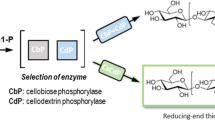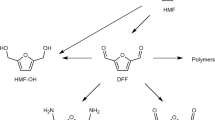Abstract
Immobilized thermostable glucose dehydrogenase from the mesophile Bacillus cereus has been prepared and used to catalyze the regeneration of NAD(P)H in enzymatic syntheses. The thermal stability of the immobilized enzyme in aqueous buffer containing NaCl is about 50,000 times that of the free enzyme. The half-life of the enzyme at 60°C is 30 minutes for the free form and more than 30 days for the immobilized form. We have used this cofactor regeneration system in the synthesis of a number of useful chiral hydroxy compounds.
This is a preview of subscription content, access via your institution
Access options
Subscribe to this journal
Receive 12 print issues and online access
$209.00 per year
only $17.42 per issue
Buy this article
- Purchase on Springer Link
- Instant access to full article PDF
Prices may be subject to local taxes which are calculated during checkout
Similar content being viewed by others
References
Mosher, H.S. and Morrison, J.D. 1983. Current status of asymmetric synthesis. Science 221: 1031–1019.
Eliel, E. and Otsuka, S. 1982. Asymmetric reactions and processes, ACS Symposium Series, American Chemical Society, Washington, D.C.
Brown, H.C., Pai, G.G. and Prabhakar, K.J. 1984. Remarkable optical induction in the reduction of α-ketoesters with β-(3-pinanyl)-9-borabicyclo[3.3.1]nonane. Synthesis of α-hydroxyesters of 100% optical purity. J. Am. Chem. Soc. 106: 1531–1532.
Midland, M.M., Greer, S., Tramontano, A. and Zderic, S.A. 1979. Chiral trialkylborane reducing agents. Preparation of 1-deuterioprimary alcohols of high enantiomeric purity. J. Am. Chem. Soc. 101: 2352–2355.
Whitesides, G.M. and Wong, C.-H. 1983. Enzymes as catalysts in organic synthesis. Aldrichimica 16: 27–34.
May, S.W. and Padgett, S.R. 1983. Oxidoreductase enzymes in biotechnology: current status and future potential. Bio/Technology 1: 677–686.
Wang, S.S. and King, C.K. 1979. The use of coenzymes in biochemical reactors. Adv. Biochem. Eng. 12: 119–146.
Klibanov, A.M. 1983. Immobilized enzymes and cells as practical catalysts. Science 219: 722–727.
Jones, J.B. 1985. Enzymes as chiral catalysts in asymmetric synthesis. In: Asymmetric Organic Synthesis, Vol. V (in the press), J. D. Morrison (ed.), Academic Press, New York.
Shaked, Z. and Whitesides, G.M. 1980. Enzyme-catalyzed organic synthesis: NADH regeneration using formate dehydrogenase. J. Am. Chem. Soc. 102: 7104.
Wichmann, R., Wandrey, C., Buckmann, A.F. and Kula, M.R. 1981. Continuous enzymatic transformation in an enzyme membrane reactor with simultaneous NADH regeneration. Biotech. Bioeng. 23: 2789–2802.
Wong, C.-H., Daniels, L., Orme-Johnson, W.H. and Whitesides, G.M. 1981. Enzyme-catalyzed organic synthesis: NAD(P)H regeneration using dihydrogen and the hydrogenase from Methanobacterium thermoautotrophicum. J. Am. Chem. Soc. 103: 6227.
Klibanov, A.M. 1983. Biotechnological potential of the enzyme hydrogenase. Process Biochem. 18: 13–16.
Wong, C.-H. and Whitesides, G.M. 1982. Enzyme-catalyzed organic synthesis: NAD(P)H regeneration using ethanol/alcohol dehydrogenase/aldehyde dehydrogenase and methanol/alcohol dehydrogenase/aldehyde dehydrogenase/formate dehydrogenase. J. Org. Chem. 47: 2816–2818.
Wong, C.-H. and Whitesides, G.M. 1981. Enzymes catalyzed organic synthesis: NAD(P)H cofactor regeneration by using glucose-6-phosphate and the glucose-6-phosphate dehydrogenase from Leuconostoc mesenteroides. J. Am. Chem. Soc. 103: 4890–4899.
Zhou, B.N., Gopalan, A.S., VanMiddlesworth, F., Shieh, W.R. and Sih, C.J. 1983. Stereochemical control of yeast reductions. 1. Asymmetric synthesis of L-carnitine. J. Am. Chem. Soc. 105: 5925–5926.
Seebach, D., Zuger, M.F., Giovannini, F., Sonnleitner, B. and Fiechter, A. 1984. Preparative microbial reduction of β-oxoesters with Thermoanaerobium brockii. Angew. Chem. Int. Ed. Engl. 23: 151.
Sih, C.J. and Chen, C.-S. 1984. Microbial asymmetric catalysis-enantioselective reduction of ketones. Angew. Chem. Int. Ed. Engl. 23: 570–578.
Wong, C.-H., Drueckhammer, D.G. and Sweers, H.M. Enzymatic versus fermentative synthesis: thermostable glucose dehydrogenase catalyzed regeneration of NAD(P)H for use in enzymatic synthesis. J. Am. Chem. Soc. In Press.
Sadoff, H.L., Bach, J.A. and Kools, J.W. 1965. Significance of multiple forms of glucose dehydrogenase in relation to its heat resistance, 97–110. In: “Spores III”. Campbell, L. L. and Halvorson, H. O. (eds.), American Society for Microbiology, Washington, D.C.
Lamed, R.J., Keinan, E. and Zeikus, J.G. 1981. Potential application of an alcohol-aldehyde/ketone oxidoreductase from thermophilic bacteria. Enzyme Microb. Technol. 3: 144–148.
Bergmeyer, H.U. 1974. Methods of enzymatic analysis, Academic Press, New York.
Dale, J.A. and Mosher, H.S. 1969. α-Methoxy-α-trifluoromethylacetic acid, a versatile reagent for the determination of enantiomeric composition of alcohols and amines. J. Org. Chem. 34: 2543–2549.
Prelog, V. 1964. Specification of the stereospecificity of some oxidoreductases by diamond sections. Pure Applied Chem. 9: 119–130.
Author information
Authors and Affiliations
Rights and permissions
About this article
Cite this article
Wong, CH., Drueckhammer, D. Enzymatic Synthesis of Chiral Hydroxy Compounds Using Immobilized Glucose Dehydrogenase from Bacillus cereus for NAD(P)H Regeneration. Nat Biotechnol 3, 649–651 (1985). https://doi.org/10.1038/nbt0785-649
Received:
Accepted:
Issue Date:
DOI: https://doi.org/10.1038/nbt0785-649
This article is cited by
-
Characterization and Application of a Novel Glucose Dehydrogenase with Excellent Organic Solvent Tolerance for Cofactor Regeneration in Carbonyl Reduction
Applied Biochemistry and Biotechnology (2023)



